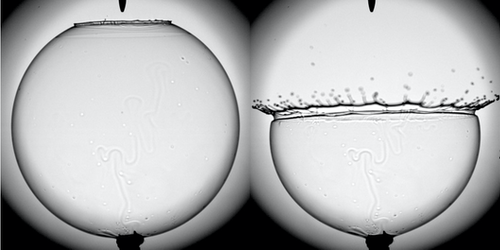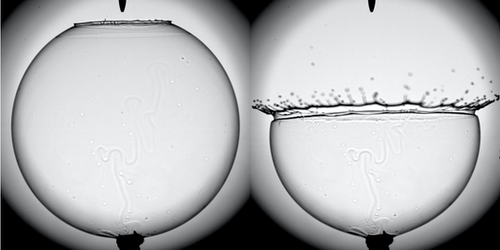Tracking Forces with Sound
When wind blows across a telephone wire it sheds vortices that generate sound. The pitch of this sound provides information about the fluid’s pressure and velocity. Applying a varying force to a fluid, for example by rotating a blade or flapping a wing, can also produce sound, but the relationship between the applied force and the acoustic emission has yet to be explored. Now Adrien Bussonnière and his colleagues at Sorbonne University in France use a bursting soap bubble to demonstrate that surface-tension-driven forces radiate a perceptible sound. The team says that their new technique can quantify the rapidly varying forces behind the sounds exerted on a fluid, such as from the rumble of bubbles rising in magma and the buzz of a bee’s wings beating the air.
Capillary forces, which arise from surface tension, act to compress the air inside a bubble. When a hole opens in the bubble’s outer liquid film, those forces become unbalanced. As a result, the rim around the hole rapidly retracts, and the hole widens. The result is a net force on the air outside the bubble, whose strength varies with the hole’s diameter.
To see if they could measure the capillary forces using sound, Bussonnière and his colleagues recorded the sound emitted as an inflating bubble ruptured. Using sensitive microphones positioned around the bubble, they distinguished the sound emitted from the widening of the hole from that emitted by the depressurizing air. The team developed a model that predicts the bubble’s thickness profile, the rupture location, and other properties of the bubble’s film from the measured sound pattern. They also captured high-speed images of the bursting bubble, which they used to confirm the acoustic signatures of the rupture process.
This research is published in Physical Review Letters.
–Rachel Berkowitz
Rachel Berkowitz is a Corresponding Editor for Physics based in Seattle, Washington, and Vancouver, Canada.





